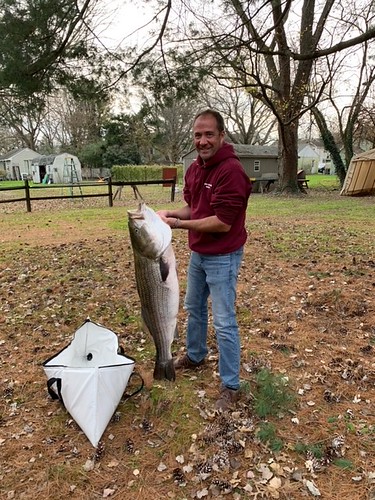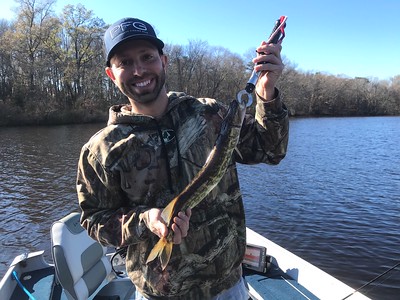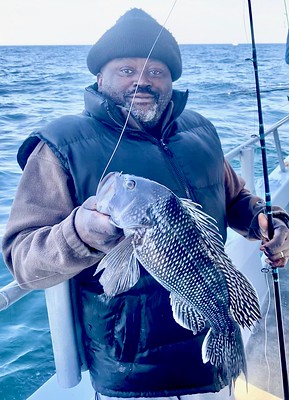Maryland Fishing Report – Nov. 25

Young angler Lucy Perez holds a string of crappie caught in the Susquehanna River. Photo by Nick Perez
From all of us at the Maryland Department of Natural Resources, we wish you a safe and enjoyable Thanksgiving holiday. Many will take advantage of some time off to go fishing or enjoy other outdoor activities. There are so many fishing options from the mountain streams of western Maryland to the waters off Ocean City.
Forecast Summary: Nov. 25 – Dec. 1:
For the holiday weekend, expect a windy start, with cool weather for the rest of the week. Surface water temperatures continue to drop as a result of cooling air temperatures and fewer daylight hours, with sunrise next week around 7:03 a.m. and a 4:45 p.m. sunset. Daytime bay water temperatures are holding in the lower 50s. Most fish including striped bass and white perch have moved towards the deeper but warmer waters as they prepare for winter in or near the river mouths. As a result of the below normal flows from the Susquehanna River, main bay salinities are slightly higher than normal. As always, best fishing areas could be further refined by intersecting them with underwater points, hard bottom, drop-offs, and large schools of baitfish.
Expect average flows for most Maryland rivers and streams. There will be above average tidal currents all week as a result of the upcoming full moon on Dec. 1.
Expect average clarity in most of the bay and rivers. However, expect reduced water clarity from algal blooms in the upper Bush, Back, Northeast, and middle Chester rivers.
To see the latest water clarity conditions, check Eyes on the Bay Satellite Maps.
For more detailed and up-to-date fishing conditions in your area of the bay, be sure to check out Click Before You Cast. Get regular updates on Maryland’s waters sent to your inbox with our Eyes on the Bay newsletter. Sign up online.
Water releases at the Conowingo Dam have been below average for quite a while now, causing low flows in the dam pool and the lower Susquehanna River. Water temperatures in the river and surrounding areas are now around 50 degrees. Those casting paddle tails and topwater lures into the dam pool, the lower river, and the Susquehanna Flats are catching striped bass in the early morning and evening hours. A fair percentage are measuring short of the 19-inch minimum mark.
Jigging and casting small crankbaits is a popular way to fish through the day, and there is the bonus of hooking up with smallmouth bass and walleye in the river. Flathead catfish are common in the dam pool, and a mix of blue and channel catfish can be found in the river and channels leading to the river.

This beautiful 44-inch striped bass showed up for Steve Wise while trolling north of the Bay Bridge recently. Photo courtesy Steve Wise.
A little farther down the bay there continues to be early morning and evening fishing opportunities for striped bass for those casting topwater lures or paddle tails with light tackle. The mouths of the Bush, Magothy, Patapsco, and Chester rivers are productive areas whether casting to shoreline structure or breaking fish.
Light-tackle jigging is always a favorite way to fish for striped bass during the fall months. The channel edges at the mouth of the Patapsco and Chester rivers, the Love Point rocks, and the Bay Bridge piers are popular places to fish. Soft plastic jigs in the 5-inch to 6-inch size range or paddle tails tend to be the favored offerings.
Trolling is certainly a viable option and the shipping channel edges at locations such as Podickory Point, Swan Point, or the channels leading out of the tidal rivers. Umbrella rigs with spoons or white sassy shads have been popular and all have to be pulled behind heavy inline weights. The striped bass tend to be holding at about 25 feet to 30 feet off the bottom. Trolling with tandem rigged bucktails or Storm shads is another way to go. Placing a few larger baits is now a very good idea as large fall migrant striped bass are showing up here and there.
White perch are being found holding over hard bottom at the mouths of the tidal rivers and a few locations out in the bay at about 25-foot depths. Bottom rigs baited with pieces of bloodworm is the best way to target them. Those casting beetle spins and working them close to the bottom in the middle to upper parts of the tidal rivers are finding yellow perch. Channel catfish can be found in every tidal river, and the Chester River is holding plenty of blue catfish in the Chestertown to Crumpton area.
Most of the striped bass fishing is focused on light-tackle jigging and trolling this week in the middle bay region. The striped bass are spread out along the major channel edges and tend to be suspended at about 25 feet to 30 feet. Water temperatures are in the lower 50’s in the bay and about 4 to 5 degrees cooler in the tidal rivers. Salinity values in the middle bay region are about 16 ppt. which is a nice comfortable value for striped bass.
Trolling is a productive way to cover a lot of water when the striped bass are spread out along the channel edges. Umbrella rigs with spoons or white sassy shads have been popular and they will need heavy inline weights to get them down to where the fish are holding. Bucktails dressed with a sassy shad or Storm swim shads have been favored trailers. Tandem rigged bucktails are working well also but will also need inline weights to get them down. Be sure to have some large lures in your trolling spread as large fall migrant striped bass are filtering up the bay this week.
The shipping channel edge from the Gum Thickets down past Bloody Point to Buoy 83 and south of the CP Buoy and the False Channel area is productive this week. On the western side of the bay, Thomas Point south past Breezy Point is another good shipping channel edge to explore. Most are reporting a slow pick since the weekend.

Christian Kinsey caught this nice striped bass off his family pier. Photo by Carolyn Kinsey
Light-tackle jigging is good wherever one can find striped bass suspended or chasing bait on the surface. Many anglers are now using heavier jigs to get down close to the bottom whether targeting suspended fish holding near channel edges or holding close to the bottom under breaking fish, which are usually smaller striped bass.
There is still some shallow-water striped bass action in the early morning and late evening hours in the lower sections of the region’s tidal rivers and Eastern Bay. Casting topwater lures or paddle tails are two of the most popular lures to cast. Water temperatures in the tidal river are coming close to 50 degrees — once they dip below 50 degrees, this shallow-water action will lessen as the striped bass go deeper for warmer and more comfortable water temperatures out in the bay.
White perch have already moved into the deeper regions of the bay and at the mouths of the major tidal rivers. A good depth finder will be needed to find them, and when they are located they will be stacked up above oyster bottom in 25 feet of water or more. As water temperatures drop into the lower 40s they will go even deeper. Pieces of bloodworm on a bottom rig is the most popular way to catch them.
The most exciting news is the arrival of some large striped bass measuring up to 40 inches in length. They are being caught by trolling large bucktails and parachutes dressed with sassy shads in tandem or behind umbrella rigs. Heavy inline weights are in order to get the rigs down to where the fish are holding along the 30-foot edges of the shipping channel. The edge from Cedar Point past Cove Point and north has been a good place to troll as well, along with the channel edge on the east side of the bay from the 76 Buoy south to Buoy 72A. Those that have some live spot on hand are also catching some of these large striped bass by live-lining along the channel edges.
Fishing for striped bass is very good at the cuts between upper and lower Hoopers Island. Casting a variety of soft plastic jigs up-current and walking the baits along the bottom as the current sweeps past is a very effective way to fish. Others are having good luck casting soft plastic jigs and paddle tails along the shores and channel edges near the mouths of the region’s tidal rivers and in Tangier and Pocomoke sounds.
Light-tackle jigging is a fun and exciting way to catch striped bass when they can be spotted chasing bait on top. Most are casting heavy jigs to get down deep underneath the surface action which is usually smaller fish to reach larger ones close to the bottom. The area near the Target Ship, Tangier and Pocomoke sounds, and the mouth of the Patuxent are reported to be excellent places to find fish this week.
White perch are being found in about 25 feet to 30 feet of water or more at the mouth of the Patuxent and Nanticoke rivers as well as Tangier Sound and the Point Lookout area. A few anglers recently reported finding some spot and kingfish mixed in with the white perch as well.
Fishing for blue catfish in the tidal Potomac from the Wilson Bridge down to the Indian Head area is exceptional. The upper Patuxent River and the Nanticoke River near Sharptown are also very good. Fresh cut bait is the most popular bait to use on a bottom rig.
Trout anglers who can brave the chillier temperatures are enjoying some fun fishing and plenty of elbow room. The western region’s catch-and-release and fly-fishing-only trout management waters provide plenty of action. In areas where brown trout are common, anglers may see some spawning activity. Various nymphs are a common choice with the caddis leading the list; streamers can also be a good choice. In the put-and-take areas throughout the state, casting small spinners and spoons is a great way to cover a lot of water for trout that tend to be spread out.
At Deep Creek Lake, fishing for walleye has been good on some of the deeper drop-off areas. White tubes rigged drop-shot fashion are one of the favored choices, as are small crankbaits. Yellow perch are being caught on minnows rigged under slip bobbers or allowed to drift deep; walleye and smallmouth bass can be part of the mix. Crappie are schooled up and holding deep near the bridge piers and can be caught on minnows or small jigs. Northern pike are very active in the deeper and larger cove areas.
The upper Potomac River is experiencing better flows and anglers report that floating leaves are not much of a problem this week. Walleye fishing is good but the fish are holding close to the bottom. Tubes and grubs in dark or natural colors with ¼-ounce jig heads are a popular choice for lures as are small crankbaits. Smallmouth bass can be a welcome part of the mix.
Largemouth bass tend to be holding along the deeper edges of drop-offs this week in many areas. As largemouth bass start to slow down due to colder water temperatures, the fish are beginning to shift into a winter mode of behavior and hold close to deeper structure — the fishing mantra of slow and small tends to be prevalent. Small lures such as silver buddies, grubs, crankbaits, and soft plastic jigs and crayfish are popular choices. The soft plastic crayfish are very popular and can be rigged Texas-style, drop-shot, Neko, or Ned-rigged. Some of the plastic crayfish even have buoyant claws now, making them even more realistic.

Photo by Herb Floyd
Chain pickerel love cold water and fishing for them this week can provide some fun and exciting action. They inhabit most tidal and nontidal waters in Maryland. They are ambush predators and will hold near structure waiting for something to swim by them. The smaller ones will be found along shorelines holding near fallen tree branches or logs. The lunker-sized pickerel will often be found out in more open and deeper waters holding near structure such as sunken wood. Chain pickerel are not too particular about lures and unfortunately often inhale them, which means treble hooks can cause severe damage to gill rakers. If targeting chain pickerel, consider rigging lures with single hooks, it will help out the fish and your fingers as well.
Crappie are schooled up deep near structure this week — bridge piers, marina docks, and fallen tree tops are great places to look for them. Minnows or small marabou jigs under a slip bobber is the best way to catch them.
Surfcasters are starting to see a few larger striped bass moving into the region along the beaches this week, as the migration from the northern states begins. Fishing with large cut baits of menhaden is the most popular method, but a gob of surf clam will work just as well — but perhaps not as durable to unwanted dinner guests.

Photo by Monty Hawkins.
At the Ocean City inlet, fishing for tautog is taking center stage, although many of the fish being caught are undersized and should be returned quickly. Pieces of green crab or sand fleas are popular baits fished tight to rocks or bulkheads. The minimum size is 16 inches with a creel limit of 4 fish per day.
Fishing for striped bass has been fun and productive in the inlet area; many of the striped bass being caught are undersized but there are enough measuring over 28 inches that most anglers will get to take a fish home. Casting soft plastic jigs or drifting cut bait tend to be the most popular ways to fish. There is also some striped bass action at the Route 90 and Verrazano bridges.
Sea bass fishing at the offshore wreck and reef sites continues to be very good with limit catches being common. A mix of large flounder and triggerfish can also be part of the mix on any given day.
The boats headed out to the deep canyons are fishing for swordfish and blueline tilefish with fair to good results.
“Tragedy and comedy in fishing are practically synonymous. It depends on who is looking and who is doing. To the former most incidents are funny, though to the latter they may be supremely tragic.” — Zane Grey
Maryland Fishing Report is written and compiled by Keith Lockwood, Maryland Department of Natural Resources fisheries biologist.
Click Before You Cast is written by Tidewater Ecosystem Assessment Director Tom Parham.
This report is now available on your Amazon Echo device — just ask Alexa to “open Maryland Fishing Report.”

 1-888-373-7888
1-888-373-7888 233733
233733